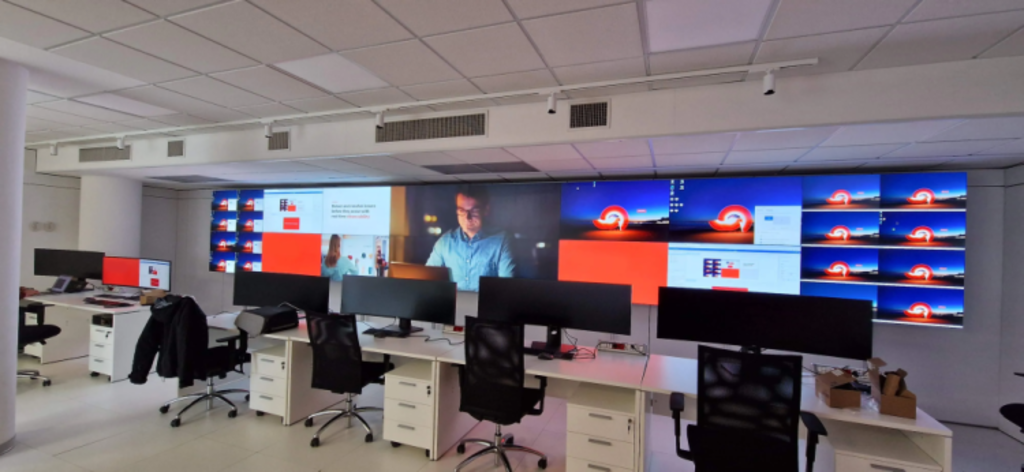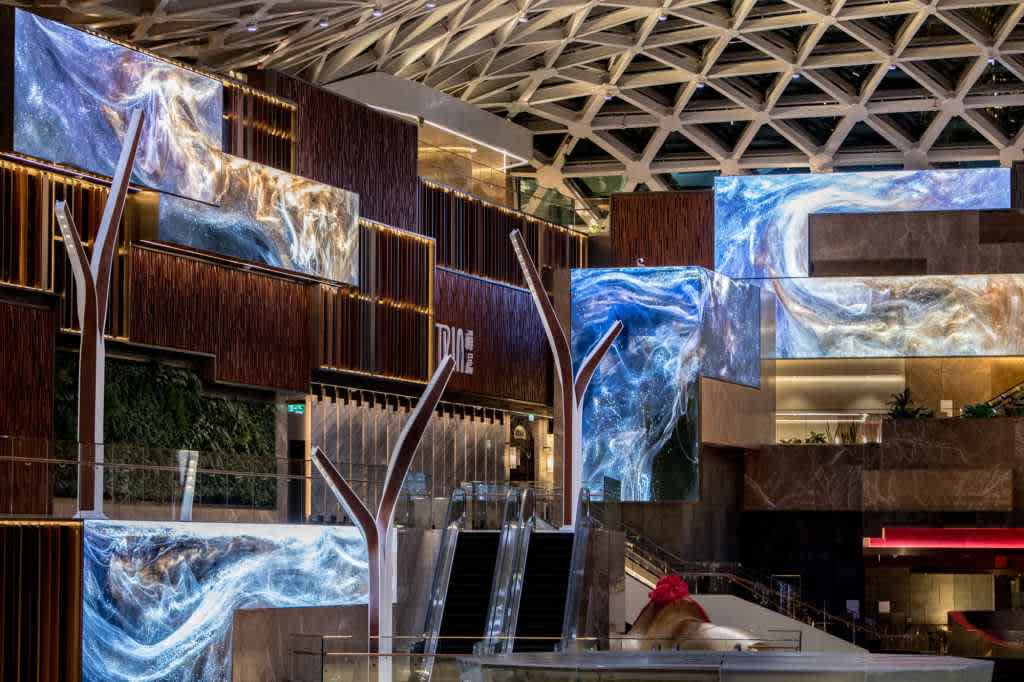Content may be king, but without the right processors and controllers, it can’t rule. Reece Webb explores the backstage tech that makes LED and videowalls shine.
If you haven’t noticed the global proliferation of LED screens then you must have been living under a rock. Today’s city streets, corporate headquarters, music venues and hospitality hotspots are full of LED displays that have redefined how we interact with the world around us. It’s easy to focus on the size, pixel pitch and brightness of a display, but there are many that will say that LED is the canvas and content is the paint. In today’s society where high quality is expected, content is truly king.
But what’s enabling showstopping content and LED displays to come together? Much like in The Wizard of Oz, it’s what’s “behind the curtain” that is truly making the magic happen. “LED processor is somewhat of a misnomer,” explains Justin Knox, marketing director, RGBLink. “Getting video content to LED display has evolved considerably from a simple DVI/ HDMI input to a SenderCard which digitises content to be received on LED panels which in turn form larger displays. Nonetheless this capability is the central requirement, even though all LED controller manufacturers now include video processing on the front side/upstream of LED processors. Video processing is the scaling engine that transforms source video content to a scale and resolution that is needed for any given LED display. This provides a sensible, efficient solution for many common LED display applications, offering an all-in-one device for video and LED processing that effectively turns the display system into a giant television.”
LED has seen wide proliferation in many industries, driven by changing perceptions and habits, as Cesar Caceres, product lead, Brompton Technology, explains: “Suddenly, you see LED everywhere and the driver of this is because of what it offers. LED can offer a higher dynamic range, which for the way we perceive quality, is very important. With the evolution of the technology, displays can go very bright, so the contrast between the brightness and darkness represents reality as closely as possible.
“You are getting finer pixel pitches and new technologies that are avoiding reflections, so you get an incredible quality of image. Now, because of advancements in personal technologies such as mobile phones, , everybody has a reference of what good quality looks like, they are used to it. During the pandemic, we saw greater demand for bigger and better, but now we are seeing a wider proliferation of applications that are viewing LED as a solution. We are seeing a demand for flexibility and wider range, not everything has to be massive. Not everybody needs the beautiful shiny tools that top-end clients in high-demand applications need. We are working with some big brands, for example in simulation and theme parks, which are places where there is a surge in demand, but audiences have more refined tastes, they want things to be high quality. We are seeing the same in live events, people want to have better experiences to add to the enjoyment of what they are doing.”
Flexible thinking
In the world of live events, designers are becoming more experimental, content is becoming increasingly more complex with growing demand for more realistic content and real-time generated visuals that wow quality-minded audiences. But this is not without its challenges: LED processors must walk a fine line to deliver results that look good, operate well and offer the much needed flexibility that end users demand.
Caceres continues: “Content must look good, because if it looks bad, there’s nothing you can do on the LED side to fix it. Likewise, if the content is good, but the LED doesn’t match it, it’s going to destroy that experience. Many companies are doing a lot of research to improve this.
“Being flexible and maintaining a system that is recognisable to engineers is a challenge. For us, the user interface is always the same, so how can you offer a UI that is as useful to someone who just wants a beautiful display and also to somebody who is making the top productions in Hollywood? In the end, the technicians are usually the same. Maintaining familiarity while offering flexibility is a big part of it. There are also new types of chips and new types of LED. Last year everybody was talking about COB and MIP, so keeping up with which technologies are going to be the standard is a challenge in itself.”
With wider deployments across a plethora of industries, system security remains a top priority when rolling out large scale LED deployments as Damon Crowhurst, sales director EMEA, Megapixel, explains: “Today, clients are far more discerning about what equipment enters their corporate networks due to security concerns. Banks, airports, casinos, and global tech firms deploy large-scale LED systems that require secure, standards-compliant, intrusion resistant processing.

Datapath technology in use at Kyndryl Cyber Operations Centre, Rome
“The biggest shift has been towards fibre-based infrastructure. We first developed and deployed this for MGM Cotai in Macau. The facility, until recently, was the largest deployment of LED under a single roof. The displays are over 2km from the control room, so the processing infrastructure had to be completely redesigned to suit these requirements. Our LED processing platform, Helios, was born from the requirements of this project, and uses fibre and corporate IT equipment for AV environments.”
Command and control
In control room environments, where the videowall often dominates the space, videowall controllers play a crucial role in ensuring rapid and clear display of content in mission-critical situations. These systems are combining clever programming and monitoring to visualise the right content at the right time in dynamic, fast paced environments, ensuring that workers can visualise, digest and react to unfolding developments at a moment’s notice.
Matthew Tibbitt, senior product manager, Datapath, explains: “In any environment where disparate sources must be ingested so visual data can be accessed by people or machines, that data needs to be presented at the right time. Modern control rooms combine workstation 4K displays, offering high pixel density at the desk, with LED videowalls that, while lower in pixel density, deliver vibrant, large-scale visualisations of higher-level content.
“The move to AVoIP continues to accelerate as things are never done in isolation now. A videowall used to be a standalone system with limited interconnectivity. Today, everything is part of a fully interconnected environment. Datapath has integrated an events engine so that we can work alongside and complement existing events that a SCADA (supervisory control and data acquisition) application may be able to generate. We can listen for those events and put an alert on a videowall or put that particular source onto the videowall to make people aware. This means that things can be monitored whilst they’re not being explicitly viewed, things can happen in the background, and a trigger can be set off. The process is more joined up as an integrated control room than it used to be.”
New standards
While LED manufacturers are offering integrated processors, standalone options continue to shine for their flexibility, especially as the industry embraces new standards. One such standard is SMPTE ST 2110, a broadcast-oriented protocol that sends video, audio, and data over IP networks.
This network-focused approach allows for much higher bandwidth and scalability, opening the door to more flexible, distributed processing architectures.
Crowhurst says: “We think processing could change dramatically in the next decade, but the trend is unlikely to shift toward fully integrated processing due to its inflexibility. SMPTE ST 2110 has already opened the door to a more network-focused approach. One of the many great things about Helios is that it’s a future-proofed distributed processing system. Our PX1 chip acts as a tile-side processor to perform tasks inside the tile that other processors do in the main processor. This enables Helios to process image data in real time, for 35 million pixels, with only 0.1 frames of delay, while consuming less than 65W of total power. With PX1, processing tasks like colour correction occur inside each tile, a major leap from how legacy systems operate.”

Megapixel products in use at MGM Cotai in Macau
Continuing this shift, Brompton is releasing its first processor with SMPTE 2110, signalling wider adoption beyond traditional broadcast. As audience expectations rise and workflows converge, the demand for broadcast-quality visuals, even in non-broadcast environments, is driving the uptake of more advanced standards.
Caceres continues: “The biggest bandwidth that we had previously is HDMI 2.0 or DisplayPort 1.4, which can hit 18-20 Gbps. With 2110, because it is network based, it can do up to 100 Gbps if done properly with the right network interface. It is a massive growth in the amount of data that you can send. We are talking finer pixel pitches, better refresh rates, everything bigger and better.”
The flexibility on signal types offered by LED processors is playing a central role in bridging the gap between video content and quality displays as Knox says: “RGBlink, like many modern video and videowall processor manufacturers, offers modular, card-frame-based devices. This allows support for a wide range of signal types, including IP sources such as common RTMP, as well as NDI, IMPX and SMPTE 2110 to be integrated with HDMI and SDI and others with relative ease. Bringing together video content of any type is at the heart of what a video processor does. From there, it standardises that content-adjusting formats, resolutions, and frame rates - to serve downstream displays and, increasingly, remote IP-based display devices, whether integrated into videowall installations or used on mobile, personal, or collaborative screens.”
Choose wisely
When faced with an expansive list of options for processors and videowall controllers, integrators must consider a plethora of factors to decide which product not only complements their chosen display but also meets the exacting needs of a client while balancing technical requirements against budget and operational simplicity.
“You need to know your source type,” says Tibbitt. “If your sources are particularly static - you might be showing spreadsheets, database entries - you’ll have a different set of requirements to more dynamic, single content environments. That might include a display showpiece-style display that may be front-of-house in a reception area, or an after-action report in a security suite where you want to review what happened during an event.
“Different challenges are going to come, because who is the end user? Who is the person consuming the content and what do they need to get out of it? If it’s more consumer-focused, you may want to prioritise vibrancy and support for HDR on inputs etc. But if you want detail, then pixel pitch could be more important, especially for the very fine lines of SCADA applications or Excel spreadsheets. You really need to understand your user’s content requirements. There’s a technical specification that you can build within LED, and videowall controllers can meet that nicely, but it’s important to remember that you can get it wrong if you’re not careful.”
Crowhurst concurs: “Integrators should select something that meets the requirements of the client. Selecting a system with ultra-low latency sounds nice, but does the client really need it? Outside of virtual production environments or real-time monitoring applications, latency is less important.
“Most clients care most about great looking images and day two operation - ensuring their display continues to perform flawlessly after installation -which means powerful monitoring tools are often high on the requirements list. Integrators should also look for the most power-efficient tools, as this is often an overlooked aspect of processing.